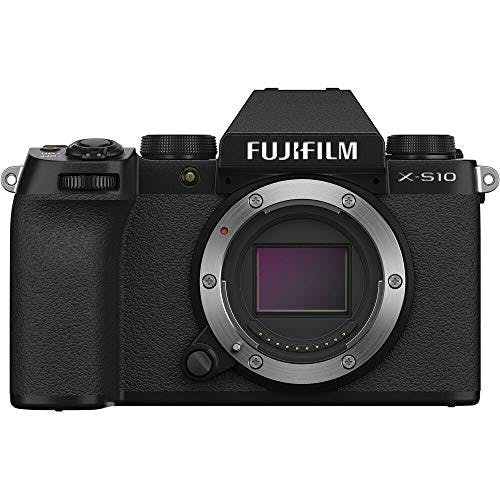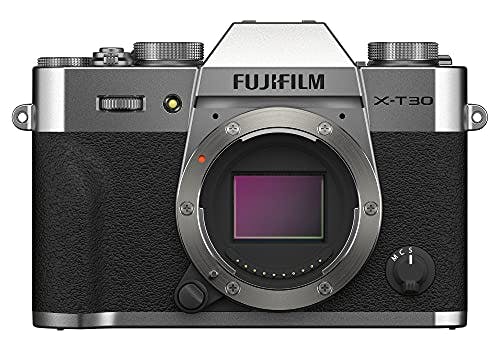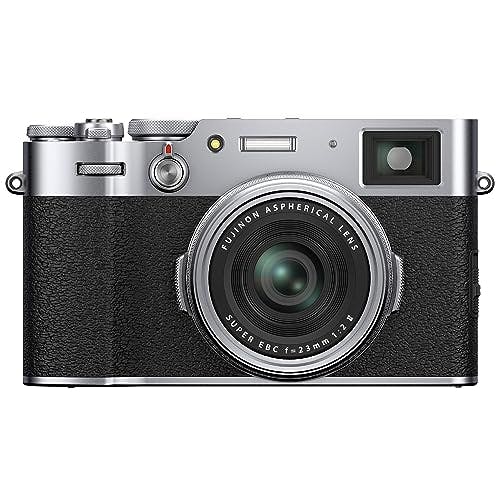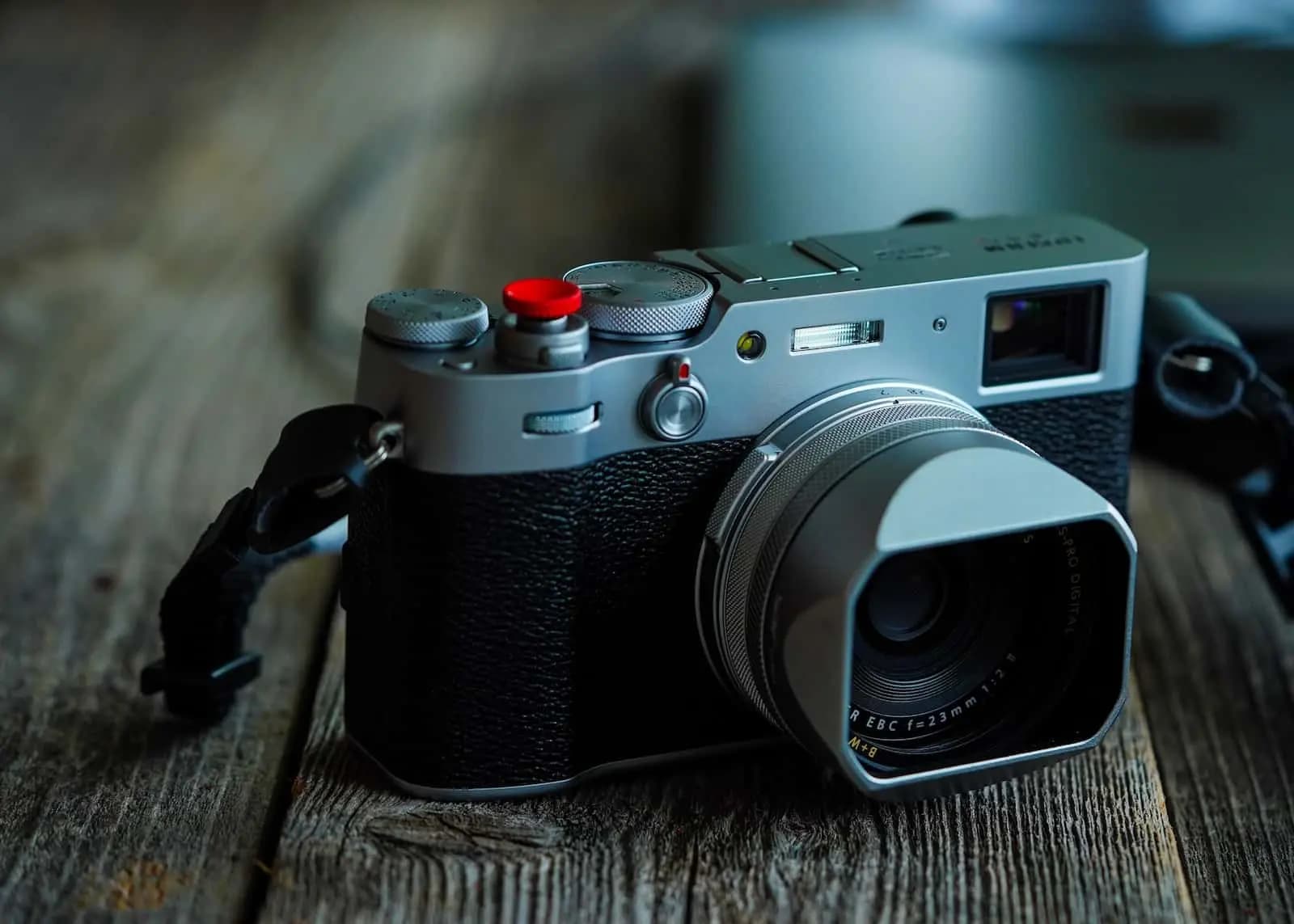Some of the links in this article may be affiliate links. We may earn a small commission if you decide to make a purchase through one of our partners, at no additional cost to you. This helps support our ongoing efforts to keep this site operating.
If you want to learn photography, you'll obviously need something to take photos with. In this guide, I'm recommending the best Fujifilm cameras for beginners.
Several years ago, I made the switch to Fuji for my professional work, and I've never looked back. I follow their releases closely and write extensively about nearly every piece of photography gear they release.
Not only are Fujifilm cameras are some of the best in the industry for quality and performance, but they are an absolute joy to shoot with. From mirrorless to medium format cameras, their lineup of digital cameras has become quite extensive.
While having options is great, the decision of which Fujifilm camera to choose as a beginner can be overwhelming. I compiled this list to help you narrow down the search and avoid a bit of stress.

Fujifilm X-S10
What I Liked:
- In-body image stabilization system rated up to 6.0 stops
- Beautiful images and color reproduction
- Articulating touchscreen is great for video
What I Didn't Like:
- No weather sealing
- Only has a single card slot
While this isn't the latest X-S Fujifilm camera, I think it aligns better with beginner photographers. Not only will you find better deals on an older model, many of its features still hold up well.
In fact, the two models share the same sensor (a 26.1MP BSI X-Trans IV CMOS sensor), ISO range of 160 to 12800 (80 to 51200 extended), hybrid autofocus system, and offer up to 20fps continuous shooting with the electronic shutter.
The Fuji X-S10 is one of the best cameras from Fujifilm for beginners because it strikes a balance between functionality and ease of use. It comes with an intuitive user interface that does not overwhelm a novice.
The simplified menu and easily accessible buttons mean that even those new to photography can navigate through settings with ease.
The camera offers both auto modes for immediate shooting and more complex settings for those who want to explore.
Another great feature of this Fujifilm camera is its in-body image stabilization (IBIS)—a feature usually found in more expensive models.
This is particularly helpful for beginners who may not have the steadiest hands or access to tripods right away. IBIS allows for more flexibility when shooting in varying lighting conditions and helps improve the sharpness of the resulting images.
The X-S10's decent sensor size also means it performs well in low-light conditions, giving beginners a broader range of environments to experiment in.
Being part of the Fujifilm X series, the X-S10 also has the advantage of a range of compatible lenses. As you become more skilled, you can invest in different lenses instead of needing to upgrade the whole camera body.

Fujifilm X-E4
What I Liked:
- Minimalistic design makes it great for street photography
- Great image quality for the price
- Quick to power up and focus
What I Didn't Like:
- Buttons are limited
- Lacks a viewfinder
The Fujifilm X-E4 also offers features that are beneficial for beginners, although it has some differences compared to the X-S10.
First, the X-E4 is more compact and lightweight, making it extremely portable. If you prioritize a camera that can easily fit into a small bag or even a large pocket, the X-E4 may be more appealing. Calling all street photographers!
However, the compact design also means it lacks the in-body image stabilization (IBIS) found in the X-S10, which could be a drawback for beginners who are looking for that extra stability.
In terms of user interface, the X-E4 leans more towards a minimalist approach. It has fewer physical controls than the X-S10, relying more on touchscreen functionalities.
This could be a plus or a minus depending on your preference. If you like straightforward, less cluttered controls, the X-E4 might be a good fit. On the other hand, if you prefer more physical dials and buttons for quicker adjustments, the X-S10 might be more to your liking.
Both cameras offer the opportunity for manual settings, so as you become more familiar with photography, you'll have the chance to experiment and learn with either model.
Both cameras use the same sensor and image processor, meaning you can expect similar image quality. They are also both compatible with the Fujifilm X-series lenses, offering you a growth path as you become more skilled and want to experiment with different focal lengths or specialized lenses.
In summary, if you're looking for a more compact, simplified experience, the X-E4 could be a better option. However, if you value additional features like IBIS and more physical controls, the X-S10 would be a better fit. Both are solid choices for beginners but offer different advantages depending on your specific needs and preferences.

Fujifilm X-T30 II
What I Liked:
- Lightweight and compact body
- Nice intro to Fuji's color science and film simulations
- Shoots 4K at 30FPS and 1080p at up to 240FPS
What I Didn't Like:
- Autofocus struggled with fast-moving subjects
- Screen only tilts
- No in-body image stabilization
The Fujifilm X-T30 II, like the X-E4 and X-S10, is another great Fujifilm camera for beginners.
The X-T30 II retains a compact form factor but adds a bit more weight compared to the X-E4. While it also lacks in-body image stabilization, it makes up for it with a more comprehensive set of physical controls.
If you appreciate tactile feedback and want more immediate access to settings without diving into menus, the X-T30 II is likely a better choice for you over the X-E4.
The user interface in the X-T30 II is more traditional, with multiple dials and buttons to facilitate quicker adjustments.
This design can be particularly useful as you gain more experience and start to manipulate settings like aperture, shutter speed, and ISO more frequently. Compared to the X-S10, the X-T30 II is somewhat simpler, which may be more approachable for beginners.
In terms of technical specifications, the X-T30 II uses the same sensor and image processor as both the X-E4 and the X-S10. This ensures consistent image quality across these models. It's also compatible with Fujifilm's X-series lenses, providing room for future growth and experimentation as you become more proficient in photography.
To summarize, the X-T30 II offers a good balance between physical controls and portability. It’s a compelling option for those who prioritize tactile controls but still want a relatively compact camera.
And if you are after a budget Fujifilm camera, you could also consider the predecessor to this Fujifilm camera—the X-T30. There are some differences, but the older version is still a solid beginner option.

Fujifilm X-100V
What I Liked:
- Sleek design
- Fantastic image clarity and color rendering
- Versatile hybrid viewfinder is a joy to use
What I Didn't Like:
- Fixed lens can be limiting
- Weather-resistance requires a lens filter ring and lens filter
The final best Fujifilm camera for beginners I'm going to recommend in this post is the X100V.
The Fujifilm X100V is a bit different from the other mirrorless cameras I've covered like the X-T30 II, X-E4, and X-S10, as it comes with a fixed 23mm f/2 lens.
This means you can't swap lenses, which might limit its versatility but can also simplify the photography process for beginners.
The lens is high-quality and suitable for a variety of general-purpose photography needs, such as street photography, portraits, and landscapes.
One standout feature of the X100V is its hybrid viewfinder, which allows you to switch between an optical and electronic viewfinder. This is unique and offers you the best of both worlds: the clarity of an optical viewfinder and the information overlay of an electronic one.
This feature might appeal to those who enjoy a more traditional photography experience but still want modern conveniences.
Technically, the X100V also sports the same sensor and image processor as the previous models, ensuring high image quality. However, it does include weather-sealing, an upgrade that provides some peace of mind if you intend to shoot in various outdoor conditions.
In summary, the X100V is ideal for those who want a simple, high-quality camera with a classic feel. It's less versatile due to its fixed 23mm lens but offers unique features like a hybrid viewfinder that aren't commonly found in other models.
I'd even go as far as saying this is the best Fujifilm camera if you're into traveling. Less gear is always something to strive for.
Things to Consider Before Buying Your First Camera
Budget
Setting a budget is one of the first steps you should take when shopping for a Fujifilm camera, especially as a beginner.
Knowing your budget helps you focus on the models you can actually afford, avoiding the frustration of falling in love with features that are out of your financial reach.
Don't just consider the initial cost of the camera body; also think about the lenses, memory cards, and perhaps even editing software you'll need. These added costs can add up.
It's easy to think that spending more will automatically make you a better photographer.
While higher-priced medium format cameras may offer more features, as a beginner, you may not need all of them right away. It's often better to start with a less expensive model and invest the money you save into learning photography skills, like courses or workshops.
Once you've built up some experience and know more about your specific interests in photography, you can always upgrade to a more advanced Fujifilm camera that fits those needs.
With new models releasing every year or two, your patience may pay off even greater.
Purpose
When you're a beginner in photography, understanding your purpose for buying a camera is crucial. The 'why' behind your purchase can guide you to the right choice.
Are you looking to capture outdoor landscapes, intimate portraits, or everyday snapshots?
Different cameras excel in different areas. For example, the Fujifilm X-T series is often praised for its versatility and could be a good all-rounder, while the X100 series, with its fixed lens, is more suited for street photography.
Another aspect of purpose is the format of your end product. Are you shooting for digital platforms, or do you plan to print your photos?
Some Fujifilm cameras, particularly those with higher-end sensors, produce images with more detail, better suited for larger prints. On the other hand, if social media is your main platform, a more basic model might suffice.
Lastly, your purpose might extend beyond the photos themselves.
Do you value a compact size for travel convenience? Some Fujifilm models are more portable than others.
Or perhaps you're drawn to the brand's reputation for mimicking the look of classic film photography. In this case, you might prioritize models offering a broader array of film simulation modes or the ability to create your own Fujifilm recipes.
Knowing your purpose helps align your needs with the features that will actually serve you, saving both time and money in the process.
Skill Level
Beginners often gravitate towards easy-to-use cameras, but it's worth considering a model that can grow with you. Luckily, many of the best Fujifilm cameras featured in this guide allow you to start shooting quickly, but also provide the tools to explore advanced techniques as you get more comfortable.
The more advanced Fujifilm models, like the X-T5, offer higher performance but come with a steeper learning curve. They provide a lot of manual control and customization options that could overwhelm a beginner.
However, if you're committed to photography as a long-term hobby or even a career, investing in a more advanced camera initially can save you from needing an upgrade too soon.
The key is to strike a balance.
Don't buy a camera so complex that it discourages you from using it. Conversely, don't settle for the simplest model and then find yourself limited in a few months.
Take the time to assess where you are in your photography journey and where you aim to be in the foreseeable future.
Your skill level should guide you in selecting a camera that not only meets your current needs but also has the capacity for your growth.
Sensor Size
When buying a Fujifilm camera, one of the key specifications to focus on is the sensor size.
In the simplest terms, the sensor is the part of the camera that captures light and converts it into an image. A larger sensor generally means better image quality, especially in low-light conditions.
Fujifilm offers bodies with various sensor sizes, ranging from smaller sensors in their compact camera models to larger APS-C and medium format sensors in their more advanced X and GFX series, respectively.
For beginners, an APS-C sensor is often a good starting point.
APS-C mirrorless cameras, such as those in the Fujifilm X series, offer a good balance between image quality and cost. They're capable of capturing detailed and vibrant photos that far exceed what a smartphone or a smaller sensor can achieve.
Moreover, APS-C sensors provide a level of depth of field control that is quite versatile, allowing for creative effects like blurred backgrounds.
If you're just starting, you might be tempted to go for the smaller sensors in Fujifilm's compact lineup due to the lower price. However, know that you'll be trading off some image quality and flexibility in lens choices.
On the other hand, jumping straight to a medium-format sensor in Fujifilm's GFX series might be overkill, both in terms of cost and the learning curve involved.
So, for most beginners, an APS-C sensor camera like those in the Fujifilm X series offers a middle ground that accommodates both budget constraints and aspirations for higher image quality.
Lens Compatibility
Fujifilm offers cameras with both fixed and interchangeable lenses.
If you opt for a fixed lens model like those in the X100 series, know that you're committed to the lens that comes with the camera.
This isn't necessarily a drawback.
Fixed lens cameras are often simpler and more portable, ideal for everyday photography. But it does mean that you can't swap out lenses to fit different shooting conditions, such as macro or telephoto photography.
On the other hand, Fujifilm's X-series and GFX-series offer interchangeable lens systems.
This allows you more creative freedom as you can switch lenses based on what you're shooting. However, be aware that lenses can be quite expensive, sometimes even more so than the camera body itself.
Additionally, you'll need to stick to lenses that are compatible with your camera's specific mount. For example, X-series cameras use the X-mount lenses, while GFX cameras require G-mount lenses.
Lens compatibility doesn't just stop at the type of mount. Pay attention to features like optical image stabilization, autofocus speeds, and aperture ranges, as these will affect your shooting experience.
Some Fujinon lenses also offer "WR" (Weather Resistance), which is useful if you'll be shooting outdoors in less-than-ideal conditions. Starting with a versatile lens like a standard zoom can be a good entry point.
As you gain more experience and understanding of your style and needs, you can invest in specialized lenses to expand your creative options.
Manual Settings
Fujifilm cameras often offer a range of manual controls that simulate the tactile experience of using a film camera. For a beginner, having manual settings can significantly aid in the learning process.
Being able to manually adjust elements like aperture, shutter speed, and ISO allows you to understand the relationship between these settings and how they impact the final image. By learning to manage these parameters, you gain a deeper understanding of photography, which automated settings can't provide.
However, manual settings can also feel overwhelming. Beginners might be tempted to rely solely on automatic modes, missing out on creative control.
Fujifilm cameras typically offer a middle-ground with "Aperture Priority" and "Shutter Priority" modes. These settings allow you to control one parameter while the camera takes care of the rest. This offers a balanced approach to gradually ease into full manual control.
Before making a purchase, check the ease of accessing these manual controls on the Fujifilm model you're interested in.
Some models feature dedicated dials for key settings, making it quicker to adjust on the fly. User-friendly manual controls will make your learning curve less steep and make the photography experience more enjoyable.
Size and Weight
One of the appeals of Fujifilm's mirrorless camera range, particularly the X-Series, is the portability factor.
These cameras often provide high-quality images without the bulk associated with DSLRs. For a beginner, this can be especially attractive.
A lighter and more compact camera is easier to carry around, increasing the likelihood that you'll take it with you and thus practice your photography more. This is especially important if you are pursuing street photography.
However, a smaller camera can also have drawbacks.
It might not fit well in larger hands, potentially making it uncomfortable to shoot for extended periods.
The reduced size can also mean fewer physical buttons and dials, leading to more time navigating menus to adjust settings. This can slow down the shooting process, which may not be ideal for capturing fast-moving subjects or moments.
If you can, handle a few different models in a store to gauge how they feel in your hands.
Think about what you'll be photographing and in what conditions. Will you be hiking and need something light? Or will you mostly be in a studio, where weight is less of an issue?
Your specific needs will help you determine what weight and size are manageable for you.
Battery Life
When you're a beginner shopping for a Fujifilm camera, the issue of battery life is more than just a technical detail; it's a practical matter that can impact your shooting experience.
Many Fujifilm models, especially the ones designed for casual users or beginners, offer decent battery life. However, certain advanced models may consume power quickly due to their high-performing sensors and continuous shooting features.
Knowing how long a battery lasts on average can help you plan your shooting sessions and avoid frustrating interruptions. While Fujifilm's battery life might suffice for everyday shots or short outings, extended photography sessions or trips could require more power.
Having spare batteries is good practice for any photographer, but it's crucial for beginners still learning how to manage power consumption efficiently. They're relatively small and not overly expensive, so carrying a couple of extras is a smart move.
Another point to consider is the charging method.
Some Fujifilm camera models allow for USB charging, which can be convenient when you're on the go. You can charge your camera through a power bank just like you would your smartphone.
This feature may not seem critical when you're close to home, but it becomes invaluable if you're traveling or spending extended periods away from a power source.
As a beginner, you might not want to get bogged down by these technicalities, but understanding your power needs can significantly improve your overall photography experience.
Megapixels
Megapixels often take the spotlight in marketing materials, tempting beginners to equate higher numbers with better quality.
But more megapixels don't guarantee better photos.
They determine the resolution of your images, useful for large prints or cropping. However, for most casual photographers, anything above 12 megapixels is generally sufficient for good-quality prints and online sharing.
When looking at Fujifilm cameras, beginners might be attracted to models with high megapixel counts, thinking this will instantly elevate their photography. But it's crucial to understand that Fujifilm cameras, particularly those in the X-series and GFX series, offer various sensor sizes and types.
These factors, combined with lens quality, often play a more significant role in determining image quality than megapixels alone.
Fujifilm's renowned color science also contributes to producing visually pleasing images, regardless of megapixel count.
For beginners, it is often more beneficial to invest in a Fujifilm camera that aligns with your needs in terms of usability, features, and budget, rather than fixating on megapixels.
Many entry-level Fujifilm cameras provide a balanced mix of megapixels, sensor quality, dynamic range, film simulation modes, and usability.
This allows you to focus on honing your skills, composition, and understanding of light, which are ultimately more important for capturing great photos.
